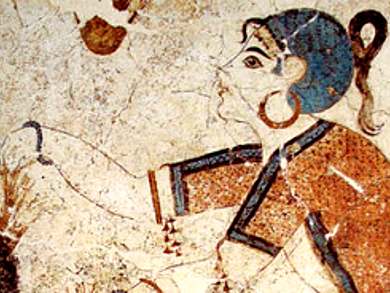Colors played a significant role in ancient times. Ancient people began to paint in caves even before they were settled in houses and were interested in architectural design. Many illustrations have been found on all continents that show how animals were crucial for the survival of human beings in the prehistoric era. These cave paintings were created during the stone age from 10,000 to 40,000 years ago.
The first cave was discovered in Altamira, Galicia (northwest Spain), in 1875, 30 km west of the city Santander (see Fig. 1). In the tholos of the cave, many huge animals were painted with black and red ochre. The outlines and black areas were made with charcoal.
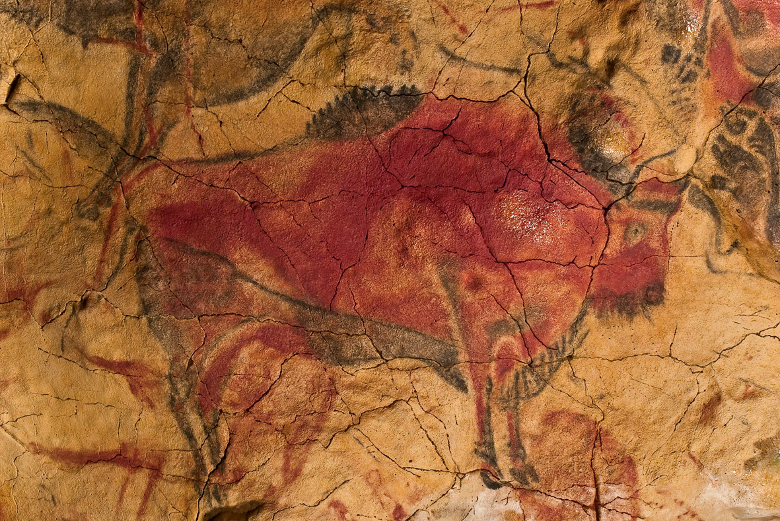
Figure 1. First cave paintings found in Altamira. © Museo de Altamira y D. Rodríguez, Wikimedia Commons, CC BY-SA 3.0
The use of colors in ancient times was not only limited to painting. It is believed that many statues and monuments that are colorless today, like the Temple of Aphaea on the Greek island of Aegina (500 BC), were painted in whole or in part and that the color has degraded over time, like the degradation of marble or stone. In the Metropolitan Museum of Art in New York, USA, there is a vase from the era of 360–350 BC that shows a man painting the statue of Hercules. Many of the creations from ancient times like ceramic figurines, temples, and statues were decorated with intense colors.
1 Analysis of Archeological Objects
The accurate and nondestructive characterization of particularly small parts of a finding can provide valuable information to an archaeologist. This includes the authenticity, the origin, the technology used in its production, the trade of each specific area, the state of conservation, and in some cases, the age of the object [1–4].
For a complete and correct study and conservation/restoration of the archaeological objects and works of art we need analytical techniques that are capable of providing information such as:
- The chemical composition to explain the origin of the object.
- The state of changes (on the surface and/or inside) as a result of small, medium, or large exposure to particular environmental conditions.
- The influence and effectiveness of the conservation/restoration processes during and after their application on the object.
An ideal method for the analysis of archaeological objects should be nondestructive and show respect for the physical integrity of the studied object. Additionally, it should be sensitive enough to detect traces of elements and be able to give information as far as the composition is concerned from even very small areas on the millimeter or even micrometer scale.
The role of analytical chemistry in the recognition and characterization of dyes that have been used in ancient times is decisive. Today, X-ray techniques with fluorescence and diffraction are an excellent tool because they can provide very important information on the mineralogical composition and crystalline structure of inorganic materials like dyes, stone, ceramic, and glass.
1.1 Microscopy and IR-Spectroscopy
Several microscopy techniques have been applied by scientists for the characterization and study of archaeological findings, such as, optical microscopy, scanning electron microscopy (SEM), transmission electron microscopy (TEM), and atomic force microscopy (AFM). In particular, with SEM, energy-dispersive X-ray analysis (EDX), and Fourier transform infrared spectroscopy (FTIR), one can study the morphology, elemental composition, and the chemical groups without destruction of the studied samples [5].
With optical microscopy, it is possible to prove the presence of inhomogeneous mixtures of elements and evaluate the shape and size of the crystals. FTIR and a series of other techniques like FTIR diffuse reflectance (FTIR-DRIFT), FTIR attenuated total reflectance (FTIR-ATR), FTIR photoacoustic spectroscopy (FTIR-PAS), and FTIR micro-spectroscopy can rapidly provide the structure of inorganic and organic materials, whereas with SEM, the structure of the sample can be evaluated.
1.2 X-Ray Diffraction
X-ray diffraction (XRD) can characterize the various crystalline phases by comparing the peaks obtained from the analysis with those reported in a database [6–8]. By using this technique, dyes used during the Egyptian period (3150–332 BC), or found in Mayan wall paintings at Ek’Balam, Yucatán, Mexico (620–700 BC), for example, have been characterized.
1.3 Raman Spectroscopy/Mass Spectroscopy/Chromatography
Another widely used technique for the characterization of archaeological objects is Raman spectroscopy [9–12]. It is suitable for the characterization and study of inorganic dyes in heterogenic mixtures, organic dyes, and modern-day synthetic dyes. Liquid and gas chromatographic techniques in combination with mass spectroscopy and detectors such as photodiode array (PDA), UV/Vis, or fluorescence, can give a complete picture of the organic compounds present in an archaeological finding.
2 Detecting Colors
Colors in ancient sculptures/statues and monuments can be detected optically without sampling by using radiation techniques such as ultraviolet fluorescence (UVF) and vaporizing iodine-labeling (VIL) techniques. With UVF photography organic and inorganic dyes can be detected; they absorb ultraviolet radiation and emit fluorescence. From this, dyes with similar optical properties but different composition can be separated and the whole object can be characterized [13–17].
VIL is a recent technique used to detect synthetic dyes such as Egyptian blue. Egyptian blue, also known as calcium copper silicate (CaCuSi4O10 or CaOCuO(SiO2)4) or cuprorivaite, is considered to be the first synthetic pigment. It was used in ancient Egypt.
The main colors used in ancient times were red, yellow, green, blue, and black.
2.1 Red
Red colors were produced by using the mineral hematitis (Fe2O3). Hematitis crystallizes only in the triangular system. It is not red but appears brown/black and in some cases only brown/red. However, when it is pulverized it is a red powder. The best quality in ancient times were the Persian and the Spanish hematitis.
The Persian hematitis obtained from the city Chourmouzios of the Persian Gulf contained 70–75 % Fe2O3. It is a brighter red than the Spanish hematitis, which contained 80–85 % Fe2O3. The red color used in the palace of Knossos, Crete, Greece, during the Minoan period (2600–1100 BC) was mainly Persian hematitis (see Fig. 2). It was also used in Hellenistic (323–31 BC) and Roman (27 BC–395 AD) times.
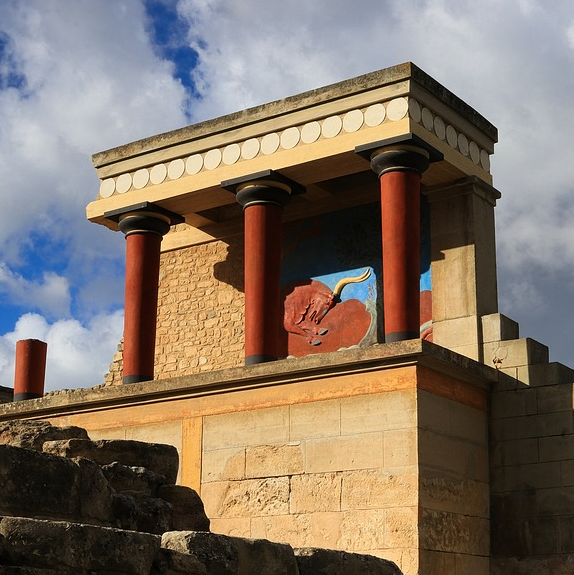 Figure 2. Palace of Knossos, Crete, Greece.
Figure 2. Palace of Knossos, Crete, Greece.
A different type of red known from ancient times is sinopia from the town Sinop in the Black Sea. This ochre had an exquisite quality and was obtained from the caves of Limnos, Greece, and Cappadocia (today Turkey).
One of the bright red colors used for fire, for example, was cinnabar or vermilion (HgS). It was obtained from a mineral of mercury (not really a mineral but a mineraloid lacking a crystal structure) after repeated heating with sulfur. Cinnabar crystallizes in a triangular system. It first appeared in the Macedonian monuments and is found in small quantities in Pontokerasia and the town Skra, Kilkis in Greece. It is also found outside Greece in many places, but always in small quantities. The biggest mine and main source of cinnabar for many centuries was Amanten, a city in Andalucia, Spain.
Besides cinnabar, an intense red color is the red of sandarac. It is a natural color, from the mineral arsenic sulfide (As2S2), which was used until the 19th century. Additionally, red lacquers of organic origin were known. Finally, a synthetic red color was minium, or red lead (Pb3O4).
2.2 Purple
Purple was considered from the beginning to be a gentle color and a symbol of Gods and Kings. It was the prettiest and most expensive dye of ancient times. Assyrians recorded two kinds of purple: Argamannu/red and Takiltu/violet, and both influenced the Persians. Later, the Greek philosopher Aristotle mentions two color varieties, the Phoenician/red and violet.
Purple from Phoenician shells was known as a textile dye. Aeschylus, an ancient Greek author, mentions that it was the most expensive dye of ancient times.
Purple colors play between blue and red. They were obtained from sea snails. Later the purple dye obtained from them was also called porphyra. The production of it was very painstaking because large quantities of shells and mollusks were required.
2.3 Yellow
The second-most-used color in the ancient prehistoric era was ochre. In nature, it exists in the mineral limonite. It is an oxide of iron but the presence of hydroxyl groups in the molecule gives a different distribution of the electrons. This leads to a different absorbance of light and, therefore, different colors. It crystallizes in the rhombic system. Large areas of “yellow land” existed in an ancient province very close to the Greek colony Μarseille in France. Limonite contains 5–20 % yellow hydrated iron oxide and the rest is clay silicate salts.
Another dark yellow color is “sienna”. It is obtained from the earth. The name originates from the town Siena in Italy where it was found. Saffron (example see Fig. 3) and egg yolk were also used to produce a yellow color. Yellow with red highlights is known as massicot, which is produced by heating lead oxide.
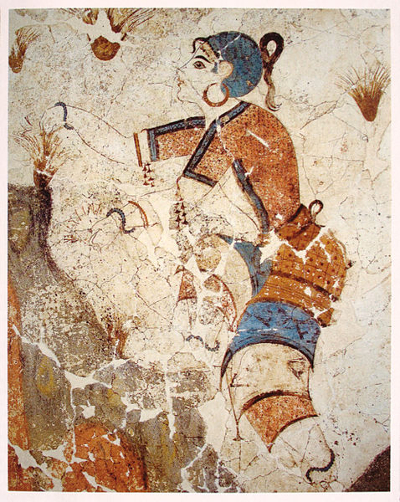 Figure 3. Detail from the “Saffron-Gatherers”, wall painting from Thera, Greece.
Figure 3. Detail from the “Saffron-Gatherers”, wall painting from Thera, Greece.
2.4 Green
Malachite (see Fig. 4) was the first green pigment to be found in historic times in Egypt as well as in all other civilizations. It was used until about 1800. It is a mineral of copper and has the green color recognizable from oxidized objects of bronze or copper. It is a double salt of copper with the chemical formula Cu2CO3(OH)2 and crystallizes in the monoclinic system. It is often found together with azurite (Cu3(CO3)2(OH)2), a soft, deep blue copper mineral. The name malachite is of Greek origin and from the plant “moloha” (mallow). Today, some of the countries that produce malachite are the Democratic Republic of the Congo, Russia, Namibia, Mexico, and the United States.
Malachite was replaced in 1800 by synthetic green dyes. Characteristic use of malachite can be seen in the decorations of the Malachite Room of the Winter Palace, Saint Petersburg; today in the Hermitage Museum of Saint Petersburg, Russia.
In Roman times, a green pigment was produced synthetically by putting copper metal in hot vinegar, acetic acid. Until the 19th century, verdigris, as this pigment was called, was the most used green pigment in paintings and architecture.
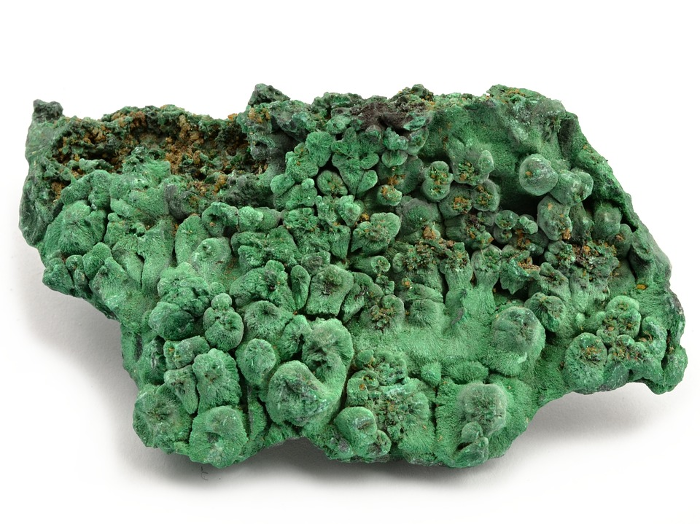 Figure 4. Malachite.
Figure 4. Malachite.
2.5 Blue
An important blue color used in ancient time was azurite. It is a copper mineral with the chemical formula Cu3(CO3)2(OH)2 [18, 19]. Today, azurite is found in Australia, southwest United States, Mexico, Morocco, and Zaire.
From the mineral lapis lazuli, blue ultramarine was obtained. It was present only in Persia. The trisulfur radical anion in the crystal is responsible for the intense blue color.
Egyptian blue (calcium copper silicate (CaCuSi4O10 or CaOCuO(SiO2)4) is believed to have been discovered accidentally at the beginning of the third millennium B.C. during experimental trials looking to replace the rare and expensive lapis lazuli. This mineral was used in glassworks and mainly in the enamel of ceramics. Egyptian glassmakers tried to color the glass blue with copper salts. From this, the unique blue dye that archaeologists found in Egypt, Mesopotamia, Crete, and Santorini, was created.
Egyptian blue is found in all painted and colored objects of all Greek and Roman findings up to 700 AC. After that, traces of it were lost although we do not know why. It appears again in the archaeology of the 19th century. Samples of Egyptian blue of the 3rd, 6th, and 14th century BC have been analyzed with X-ray diffraction and atomic absorbance. These samples were Roman from Malta and from the villa of Hadrian in Tivoli, Italy, and also from Mesopotamia of the 7th and 9th centuries. Analyses of all samples showed differences in the blue hue and in the crystalline structure: CuO: 10–21 %, SiO2: 5–78 %, CaO: 7–15 %, Na2O: 0.1–3.9 %.
Crystallographic studies showed that Egyptian blue was the result of the reaction of the four oxides in the solid state. Places where significant objects were found are Knossos on Crete in Greece, on the Greek island Santorini/Thera, in Mycenae near Mikines in Greece, and the Greek city of Tiryns in the Peloponnese.
2.6 Black
In 1973, X-ray diffraction and fluorescence analysis were performed on the dyes of the wall paintings of Knossos on Crete (see Fig. 2), Greece, and the Greek island Santorini (classically Thera). The black color was found to be carbon, the most significant chemical element that has been used as a color. It was acquired from the combustion of bones. However, the best black color was derived from charred ivory. Black was also derived from the combustion of wood.
The best wood charcoal was derived from new shoots of trees. To be used as a color, it was transformed into a powder. Good quality black powder was derived from the peach pit and shells of almonds. X-ray diffraction analysis showed that manganese was responsible for the black color in the form of Mn3O4 and MnO2.
2.7 Tempera
A particularly interesting finding was that of a laboratory for the production of colors in the ancient agora (a central public space in ancient Greek city states) of the Greek island of Kos. The building was built in 366 BC. It started during the Roman period with the production of technical dyes. These are physical dyes that were produced from other minerals by heating rather than being removed from mines.
In the wall paintings of Pompeii in Italy, we found, for the first time, a “binding medium” mixed into the colored pigments (see Fig. 5). Tempera was the first color in which a binding medium had been used. Together with fresco (pigments mixed with water and used on a thin layer of wet, fresh plaster; after drying, the pigment particles are fixed into the plaster), tempera was a unique way of painting for thousands of years.
The binding medium was always a polymer. As a binding medium, egg white (protein) and gum arabic (polysaccharide, copolymer of galactose, raminose, arabinose, and glucuronic acid) have been used. Tempera has also been found in the decoration of many Egyptian carnivores. Tempera made the colors very long lasting.
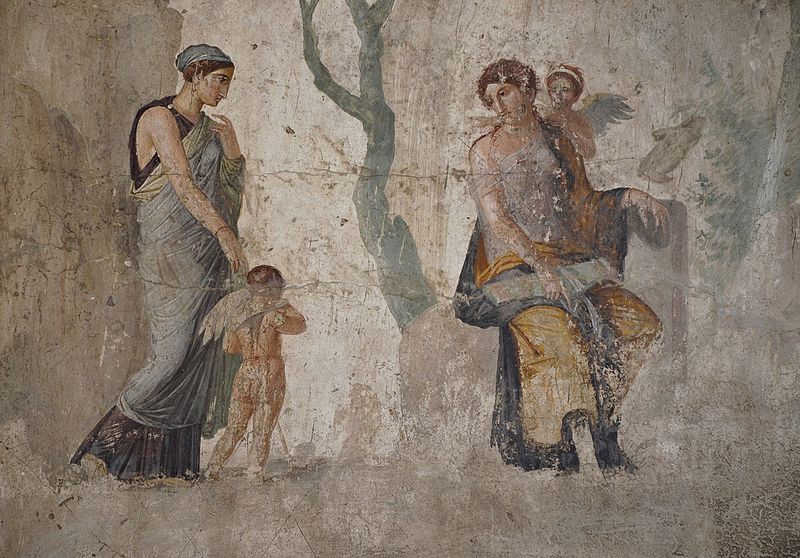
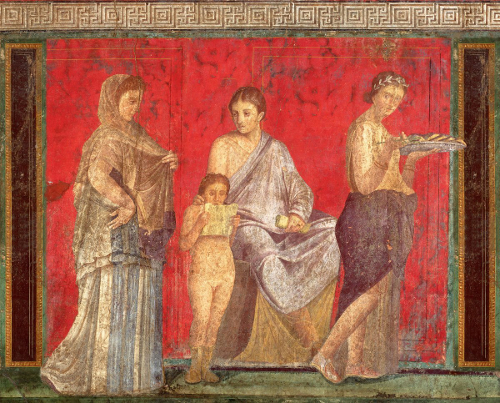
Figure 5. Wall paintings in Pompeii, Italy. (© left Carole Raddato from FRANKFURT, Germany, Wikimedia Commons, CC BY-SA 2.0)
3 Conclusion
Many antique pieces have survived till today in which one can see the authentic color or color pigments used by the artist. Examples are the known “Parisian woman” (see Fig. 6) and the “Bull Dancers” (see Fig. 7).
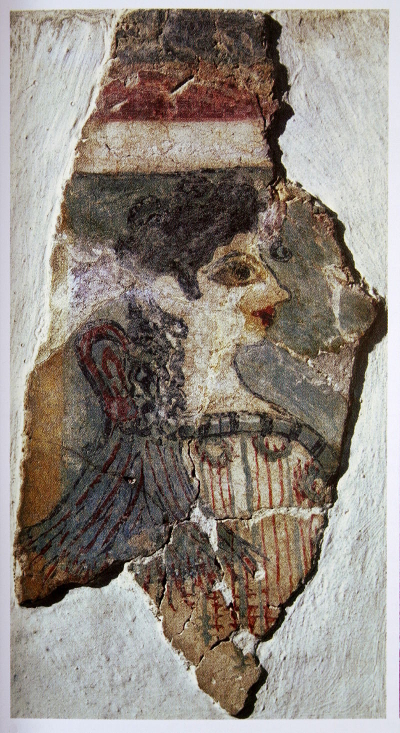 Figure 6. The “Parisian”, fresco, Knossos, Crete, Greece.
Figure 6. The “Parisian”, fresco, Knossos, Crete, Greece.
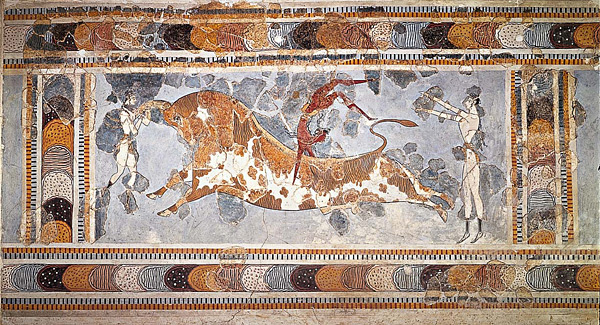
Figure 7. Wall painting of “Bull Dancers”, fresco Knossos, Crete, Greece, about 1500 BC.
In these, one can see clearly the authentic ochre, hematite, malachite with carbon in the hair, and Egyptian blue in the clothing. In the wall painting of dolphins in the palace of Knossos, the blue unfortunately is not authentic (see Fig. 8). It is a modern dye from the beginning of the century. The optical impression, however, is very close to reality.
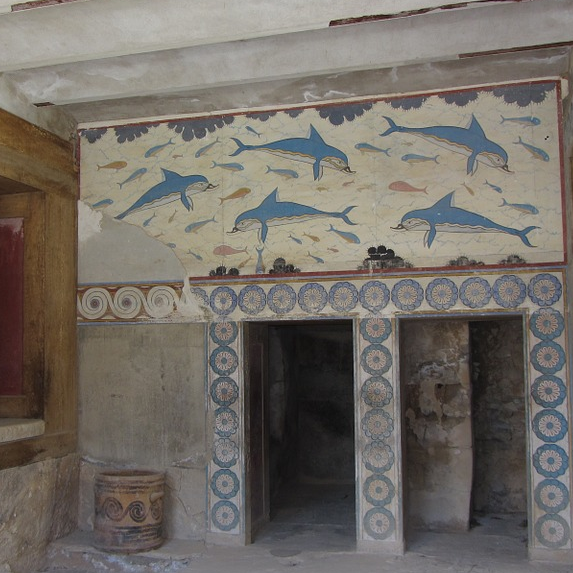
Figure 8. Wall painting of dolphins in the palace of Knossos, Crete, Greece.
References
[1] E. Ciliberto, G. Spoto, Modern Analytical Methods in Art and Archaeology, Chemical Analysis Series, Vol. 155, Wiley, Chichester, 2000. ISBN: 047129361X
[2] A. M. Polland, C. Heron, Archaeological Chemistry, Royal Society of Chemistry, London, UK, 1996. ISBN 0-85404-523-6
[3] Maria Perla Colombini, Alessia Carmignani, Francesca Modugno, Fabio Frezzato, Angela Olchini, Hariclia Brecoulaki, Vivi Vassilopoulou, Panagiotis Karkanas, Integrated analytical techniques for the study of ancient Greek polychromy, Talanta 2004, 63(4), 839–848. https://doi.org/10.1016/j.talanta.2003.12.043
[4] G. A. Mazzocchin, F. Agnoli, I. Colpo, Investigation of roman age pigments found on pottery fragments, Anal. Chim. Acta 2003, 478, 147–161. Link
[5] X. Adriaens, M. G. Dowsett, Electron Microscopy and its role in cultural heritage studies, in Comprehensive Analytical Chemistry XLII (Eds: Janssens, Van Grieken), Chapter 3, Elsevier, Amsterdam, The Netherlands 2004.
[6] S. Profi, L. Weier, S. E. Filipakis, X-ray analysis of Greek Bronze age pigment from Knossos, Studies in Conservation 1976, 21(1), 34–39. https://doi.org/10.2307/1505608
[7] M. C. Edreira, M. J. Feliu, C. Fernandez-Lorenzo, J. Martin, Roman wall paintings characterization from Cripta del Museo and Alcazaba in Merida (Spain): chromatic, energy dispersive X-ray fluorescence spectroscopy, X-ray diffraction and Fourier transform infrared spectroscopic analysis, Anal. Chim. Acta 2001, 434(2), 331–345. https://doi.org/10.1016/S0003-2670(01)00847-9
[8] D. C. Creagh, D. A. Bradley, Radiation in Art and Archeometry, Elsevier, Amsterdam, The Netherlands, 2000. ISBN: 9780080540191
[9] P. Vandenabeele, S. Bodé, A. Alonso, L. Moens, Raman spectroscopic analysis of the Maya wall paintings in Ek’Balam, Mexico, Spectrochim. Acta Part A: Molec. Biomol. Spectr. 2005, 61(10), 2349–2356. https://doi.org/10.1016/j.saa.2005.02.034
[10] P. M. Ramos, I. Ruisanchez, K. S. Andiakopoulos, Micro Raman and X-Ray fluorescence spectroscopy data fusion for the classification of ochre pigments, Talanta 2008, 75(4), 926–936. https://doi.org/10.1016/j.talanta.2007.12.030
[11] Gregory D. Smith, Robin J. H. Clark, Raman microscopy in archaeological science, J. Archaeol. Sci. 2004, 31(8), 1137–1160. https://doi.org/10.1016/j.jas.2004.02.008
[12] P. Vandenabeele, Raman Spectroscopy in Art and Archaeology, J. Raman Spectr. 2004, 35(8-9), 607–609. https://doi.org/10.1002/jrs.1217
[13] Tracking Colour, The Polychromy of Greek and Roman Sculpture in the Ny Carlsberg Glyptotek, art museum in Copenhagen, Denmark, Preliminary Report 2, 2010.
[15] G. Verri, The application of visible-induced luminescence imaging to the examination of museum objects, Proc. of SPIE 2009, 7391. https://doi.org/10.1117/12.827331
[16] Vincent Brinkmann, Die Polychromie der archaischen and frühklassischen Skulptur, Biering und Brinkmann, München, Germany, 2003. ISBN 9783930609192
[17] Nikos Kapetanidis, Colors of Painting and Architecture-Chemistry of Colors, Ziti Publications 2005.
[18] Gian Antonio Mazzocchin, Danilo Rudello, Carlo Bragato, Francesca Agnoli, A short note on Egyptian blue, J. Cult. Heritage 2004, 5(1), 129–133. https://doi.org/10.1016/j.culher.2003.06.004
[19] M. Sanchez del Rio, P. Mrtinetto, A. Somogyi, C. Reyes-Valerio, E. Dooryhee, N. Peltier, L. Alianelli, B. Moignard, L. Pichon, T. Calligaro, J. C. Dran, Microanalysis study of archaeological mural samples containing Maya blue pigment, Spectrochim. Acta Part B: Atom Spectr. 2004, 59(10-11), 1619–1625. https://doi.org/10.1016/j.sab.2004.07.027
The article has been published in Greek as:
- Τα αρχιτεκτονικά χρώματα – στην προϊστορική και αρχαϊκή εποχή,
Evrykleia G. Karagiannidou (Ευρύκλεια Γ. Καραγιαννίδου),
Chemica Chronica (Association of Greek Chemists Magazine) 2014, 76 (5), 18–25.
Link to Chemica Chronica
and was translated by Evrykleia G. Karagiannidou.
